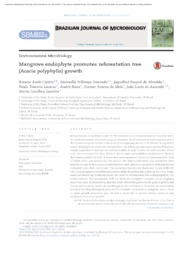Mangrove endophyte promotes reforestation tree (Acacia polyphylla) growth.
Mangrove endophyte promotes reforestation tree (Acacia polyphylla) growth.
Summary: Mangroves are ecosystems located in the transition zone between land and sea that serve as a potential source of biotechnological resources. Brazil's extensive coast contains one of the largest mangrove forests in the world (encompassing an area of 25,000 km2 along all the coast). Endophytic bacteria were isolated from the following three plant species: Rhizophora mangle, Laguncularia racemosa and Avicennia nitida. A large number of these isolates, 115 in total, were evaluated for their ability to fix nitrogen and solubilize phosphorous. Bacteria that tested positive for both of these tests were examined further to determine their level of indole acetic acid production. Two strains with high indole acetic acid production were selected for use as inoculants for reforestation trees, and then the growth of the plants was evaluated under field conditions. The bacterium Pseudomonas fluorescens (strain MCR1.10) had a low phosphorus solubilization index, while this index was higher in the other strain used, Enterobacter sp. (strain MCR1.48). We used the reforestation tree Acacia polyphylla. The results indicate that inoculation with the MCR1.48 endophyte increases Acacia polyphylla shoot dry mass, demonstrating that this strain effectively promotes the plant's growth and fitness, which can be used in the seedling production of this tree. Therefore, we successfully screened the biotechnological potential of endophyte isolates from mangrove, with a focus on plant growth promotion, and selected a strain able to provide limited nutrients and hormones for in plant growth.
Publication year: 2018
Types of publication: Journal article
Unit: Embrapa Environment
Observation
Some of Embrapa's publications are published as ePub files. To read them, use or download one of the following free software options to your computer or mobile device. Android: Google Play Books; IOS: iBooks; Windows and Linux: Calibre.
Access other publications
Access the Agricultural Research Database (BDPA) to consult Embrapa's full library collection and records.
Visit Embrapa Bookstore to purchase books and other publications sold by Embrapa.

